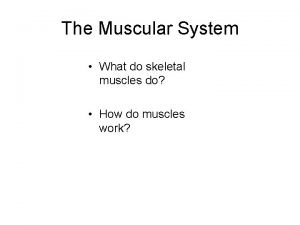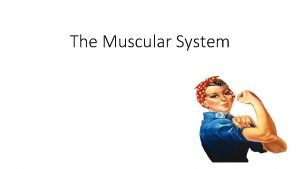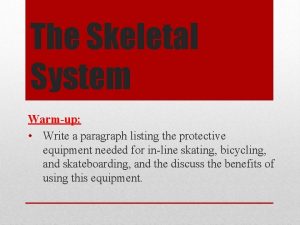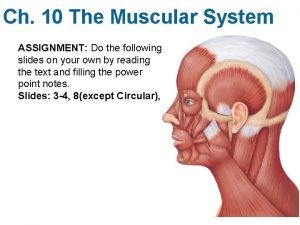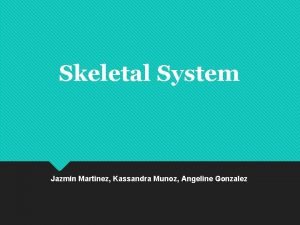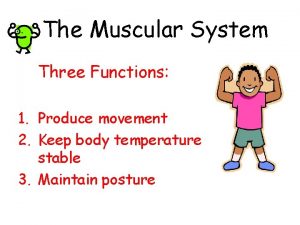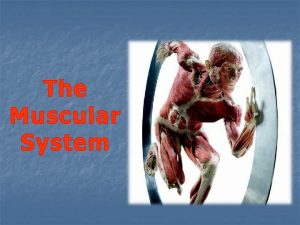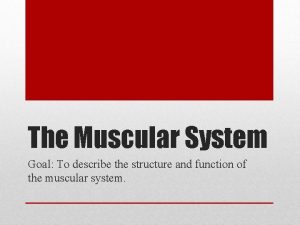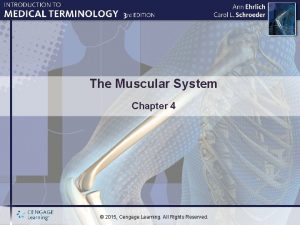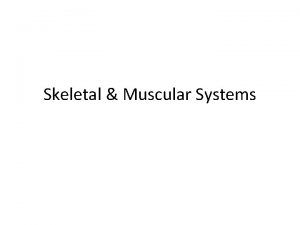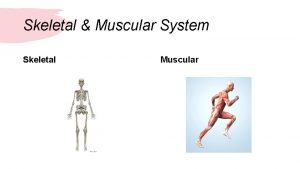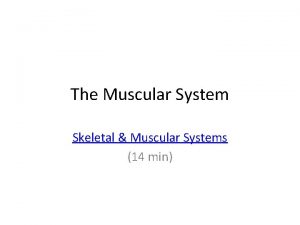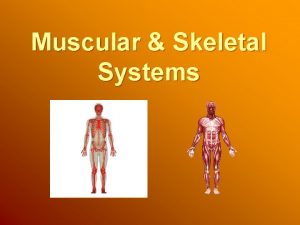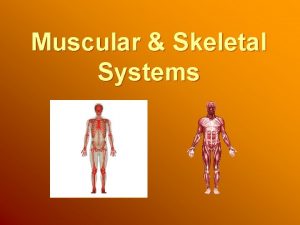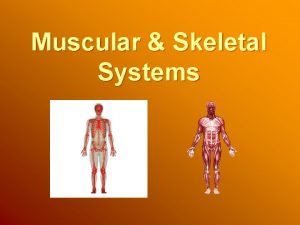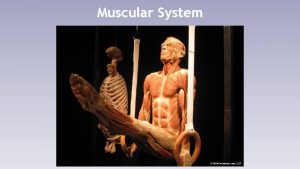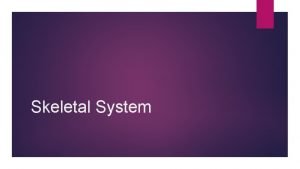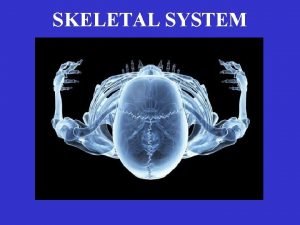YOUR SKELETAL AND MUSCULAR SYSTEMS Your Skeletal System













- Slides: 13

YOUR SKELETAL AND MUSCULAR SYSTEMS

Your Skeletal System � � Your SKELETAL SYSTEM- the framework of bones and other tissues that supports the body. Made up of bones, joints, and connective tissues. Over 200 bones in the human body Most adults have 206 bones

Functions of the Skeletal System � � � The Skeletal system has numerous functions Movement- your bones and muscles work together to help you move Support- your bones and muscles help hold you in positions Protection- some bones protect important internal organs Produce and store needed materials � Red blood cells are produced in bones � Fat and calcium are stored in bones

Connective Tissues � � � There are different connective tissues that help you move and protect your bones. JOINTS- places where two or more bones meet. Joints provide flexibility and allow movement. Two types of joints Immoveable and moveable. LIGAMENT- a type of connecting tissue that holds bones to other bones at the joint

Connective Tissues � � � There are different connective tissues that help you move and protect your bones. CARTILAGE- a strong, flexible tissue that allows joints to move easily, cushions bones, and supports soft tissues. Cartilage protects bones from wear and tear, like in the knee and elbow. TENDONS- a type of connecting tissue that joins muscles to bones and muscles to muscles. Tendons help keep joints from moving out of place.

Your Muscular System � � � MUSCULAR SYSTEM- tissues that move parts of the body and control the organs. Also provide stability and protection and maintain body temperature. To maintain body temperature your muscles contract quickly and cause you to shiver when you are cold, when you are warm the body may sweat. Muscles work by contracting When a muscle contracts it gets shorter, when it relaxes it returns to its normal length.

Types of Muscles � � There are 3 types of muscles: skeletal, cardiac, and smooth. CARDIAC MUSCLE- muscle found in the walls of the heart. Involuntary muscles, they work on their own without your control. Pump blood through the heart and body.

Types of Muscles � � � SMOOTH MUSCLE- type of muscle found in organs and in blood vessels and glands. Involuntary muscles. Blood vessels, the stomach, bladder, intestines all contain smooth muscle. Contraction of smooth muscle controls the movement of blood through the vessels Contraction also helps move food and waste through the body.

Types of Muscles � � � SKELETAL MUSCLE- muscle attached to bones that enables you to move your body. Voluntary muscles: you control the muscles to make your body move. Skeletal muscles work by pulling on your bones not pushing. Every movement is a result of a muscle pulling on a bone. Muscles work together to create movement, this is called paired movement. Paired movement, when one muscle contracts, another relaxes.

Problems With Bones and Muscles � � � Injury, infection, poor posture, lack of good nutrition cause problems with the bones and muscles. Fracture- break in a bone caused by injury Dislocation- when a bone is pushed out of a joint, may cause damage to a ligament as well. Sprain- injury to a ligament where it is stretched or twisted. Strain- small tear in a muscle or tendon. Sometimes called a pulled muscle. Can occur when a muscle is over stretched.

Problems With Bones and Muscles � � Overuse Injuries- happen over a period of time of using a muscle too much for too long and not letting it rest. Osteoporosis- results in brittle and weak bones, caused by lack of nutrition and exercise. Scoliosis- curving of the backbone. The spine will curve to one side of the body in an s or c shape. Muscular dystrophy- weakens the muscles over time. Usually inherited and causes skeletal muscle tissue to gradually waste away.

Caring for Your Bones and Muscles � � � Proper nutrition is needed to keep bones and muscles in good shape. Exercise and physical activity help keep bones and muscles strong. Decreased muscle strength can increase the chanced of heart disease and make joints less stable. Flexibility will help you move more easily and decrease the chances of injury. Warm up and cool down before and after exercise Allow your body time to recover.

Caring for Your Bones and Muscles � � � Posture- the way you hold your body. Good posture means the bones and joints in your back stay in place and the muscles are used properly. To reduce strain on the back: Lift with your legs when lifting something heavy. Carry your backpack properly and avoid making it too heavy.
 Chapter 36 skeletal muscular and integumentary systems
Chapter 36 skeletal muscular and integumentary systems Chapter 14 the skeletal muscular and nervous systems
Chapter 14 the skeletal muscular and nervous systems Major skeletal muscles
Major skeletal muscles Skeletal and muscular system
Skeletal and muscular system Plyometrics disadvantages
Plyometrics disadvantages Whats the muscular system
Whats the muscular system How to take care of your skeletal system
How to take care of your skeletal system Muscular system head and neck
Muscular system head and neck Skeletal interactions with other systems
Skeletal interactions with other systems Pectoral girdle acetabulum
Pectoral girdle acetabulum What do muscles move
What do muscles move Naming muscles
Naming muscles 5 function of muscular system
5 function of muscular system Chapter 4 the muscular system labeling exercises
Chapter 4 the muscular system labeling exercises


